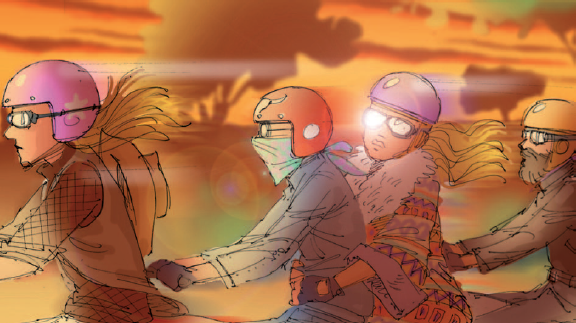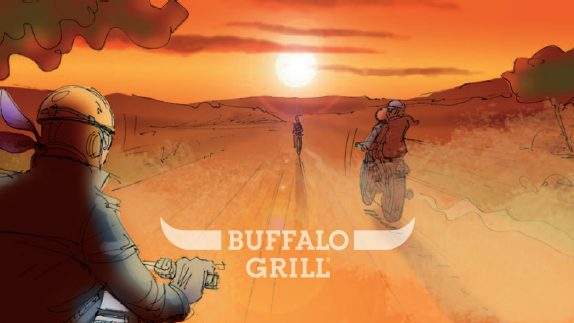The idea of the piece was simple, just visuals of a few motorcyclists riding through the desert. The agency had already drafted up several boards before I was hired, so the look they were going for was fairly clear.



I took the obvious cues from the boards that the client wanted a flared out, extremely warm look for the piece. The director was also set on shooting purely during magic hour, which was the first time I have had the luxury of planning our day strictly around the sunlight. But since we only had to shoot for 6 shots, it made everything possible.
We shot on the RED Epic, with a timebase of 25fps for PAL. In order to achieve the flared out look, we chose to shoot on Russian square-front Lomo Anamorphics from HD Planet Cameras. These lenses are great because they are fairly affordable (as far as anamorphics are concerned) and give some really pronounced flares. Aside from the normal drawbacks of shooting anamorphic, the downside to these lenses is that they are extremely soft, especially around the edges. But their imperfections can make for a unique image. Filtration was fairly clean aside from the usual ND's and a few ND Grads on the wider frames. We also brought along a set of diopters for safety, since anamorphics in general have a fairly limited close focus.
One of the "lessons" I have been picking up on lately is how incredibly important it is to scout the location multiple times of the day to notice how the sun plays in the proposed scene/shot. Coming from low budget film-making there is seldom time to scout the location more than once before a shoot, which is often just a tech scout going over the logistics of the day. With this project and a few in the past, we have had the luxury of making multiple visits to the location in order to pick the best time of day to shoot each scene. Especially with this project, it was critical we achieved the final frame in which the motorcyclists ride "into the sunset". Finding a road that aimed directly East/West as well as determining the exact time the sun went behind the mountains was crucial for this piece. The director arrived from France and drove out several days early to conduct these scouts. He shared his info with me in the form of Panascout iPhone photos:
We shot on the RED Epic, with a timebase of 25fps for PAL. In order to achieve the flared out look, we chose to shoot on Russian square-front Lomo Anamorphics from HD Planet Cameras. These lenses are great because they are fairly affordable (as far as anamorphics are concerned) and give some really pronounced flares. Aside from the normal drawbacks of shooting anamorphic, the downside to these lenses is that they are extremely soft, especially around the edges. But their imperfections can make for a unique image. Filtration was fairly clean aside from the usual ND's and a few ND Grads on the wider frames. We also brought along a set of diopters for safety, since anamorphics in general have a fairly limited close focus.
One of the "lessons" I have been picking up on lately is how incredibly important it is to scout the location multiple times of the day to notice how the sun plays in the proposed scene/shot. Coming from low budget film-making there is seldom time to scout the location more than once before a shoot, which is often just a tech scout going over the logistics of the day. With this project and a few in the past, we have had the luxury of making multiple visits to the location in order to pick the best time of day to shoot each scene. Especially with this project, it was critical we achieved the final frame in which the motorcyclists ride "into the sunset". Finding a road that aimed directly East/West as well as determining the exact time the sun went behind the mountains was crucial for this piece. The director arrived from France and drove out several days early to conduct these scouts. He shared his info with me in the form of Panascout iPhone photos:
The shoot was executed as planned, shooting the "sunset shot" at sunrise, and then moving on to the tracking shots. We made it a point to shoot into the sun as much as possible to keep the flared look. Once the sun was out of frame (10am) we took a 3-4hr break from filming. We got back around 2pm and focused on shooting a few of the closeup insert shots (not every one made the cut). Although the sun was still high, we minimized that with silks overhead and used shinyboards to give a hard side light and simulate the setting sun. We also did our best to hide flares. Below is a frame from one of those shots:
With a little help in DaVinci Resolve Lite, we balanced the various times of day and added warmth so that the piece retains a fairly cohesive look. Here it is!




























